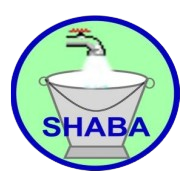This proposal, developed by SHABA (Shirkadaa Adeegyada Bulshada Awdal) in collaboration with UNICEF and the Ministry of Water Resources Development (MoWRD) of Somaliland, addresses the critical issue of water scarcity in Borama town. The initiative aims to augment the Amoud/Dhamoug aquifer’s production capacity through the construction of forced recharge systems and watershed management schemes. The project spans six months, with a total budget of $799,160, of which 62.56% is contributed by UNICEF and 37.54% by MoWRD. It targets a population of 300,000, comprising 50,000 households, including women, children, and marginalized urban communities.
Acknowledgments
The proposal acknowledges the collaborative efforts of various stakeholders. SHABA’s leadership, the President of Somaliland, and technical teams from MoWRD have prioritized addressing Borama’s water crisis. The regional coordinator of MoWRD, SHABA’s technical staff, and international partners have contributed significantly to the project’s design and planning.
Background and Problem Statement
Borama town is situated in a mountainous area with an average annual rainfall of 540mm, higher than other regions in Somaliland. However, the region faces significant challenges in utilizing this resource effectively. Most rainwater is lost as runoff, causing soil erosion and failing to recharge groundwater sources. Over the years, rapid urbanization, population growth, and climate change have compounded the water scarcity crisis. Historically, Borama relied on shallow boreholes and hand-dug wells, which have become increasingly unviable due to over-extraction. A total of 12 production wells have dried up, with the aquifer’s water table dropping at an alarming rate of 8m per year.
Comprehensive hydrological studies conducted by SHABA and international organizations revealed that while deeper boreholes have been drilled to meet growing demand, the depletion of the aquifer persists. The current water supply of 5,200 cubic meters per day falls significantly short of the estimated daily demand of 12 million liters for Borama’s 300,000 residents. If no immediate interventions are implemented, the aquifer risks irreversible collapse.
Objectives
The project’s primary goal is to improve living conditions in Borama by ensuring a sustainable and adequate water supply. This will be achieved by increasing the production capacity of the Amoud/Dhamoug aquifer through innovative watershed management techniques and artificial recharge schemes. The project seeks to reverse aquifer depletion, mitigate the effects of climate change, and provide clean water access to improve public health and living standards.
Proposed Solutions and Activities
The proposal outlines a comprehensive strategy for watershed management and artificial recharge. It includes the construction of three earth dams and six sand dams to enhance groundwater recharge. Two dried-up boreholes will be revitalized through forced recharge systems. Additionally, soil bunds, gully protections using gabion baskets, and water conservation systems will be implemented. Indigenous tree planting initiatives will further promote infiltration and aquifer sustainability.
Community engagement is a cornerstone of the project. SHABA and MoWRD will work closely with local residents to raise awareness and build capacity for long-term water management. Training programs will be provided for technical staff and water user associations to ensure the sustainability of the implemented measures.
Importance of Water Harvesting
The project underscores the critical role of water harvesting in addressing Borama’s water crisis. Rainwater harvesting technologies, such as contour bunds, trapezoidal bunds, and semi-circular hoops, will capture and store runoff for agricultural and domestic use. Techniques like floodwater harvesting and groundwater dams will enhance aquifer recharge, mitigate drought effects, and reduce soil erosion. Long-term measures, including the construction of reservoirs and embankment-type ponds, will further strengthen water storage capacity.
Project Outcomes
The anticipated outcomes of the project include a significant increase in the aquifer’s recharge capacity and a reduction in the water table’s rate of decline. Improved water supply will reduce waterborne diseases and enhance public health. Enhanced soil and water conservation measures will promote ecological balance and agricultural productivity. The initiative aims to bridge the gap between Borama’s water supply and demand, ensuring a sustainable solution for the town’s growing population.
Budget Overview
The total project budget of $799,160 is allocated across multiple activities, including the construction of earth dams ($475,200), sand dams ($342,360), and soil bunds and gully protections ($95,560). The Ministry of Water Resources Development will contribute $300,000, while UNICEF will provide $499,160. These funds will cover mobilization, construction, training, and community engagement activities.
Conclusion
This project represents a critical intervention to address the escalating water scarcity in Borama. By implementing forced recharge systems, watershed management techniques, and community-led initiatives, the proposal aims to secure a sustainable water supply for the town’s present and future needs. Immediate action is necessary to prevent further depletion of the Amoud/Dhamoug aquifer and to improve the quality of life for Borama’s residents.


No responses yet